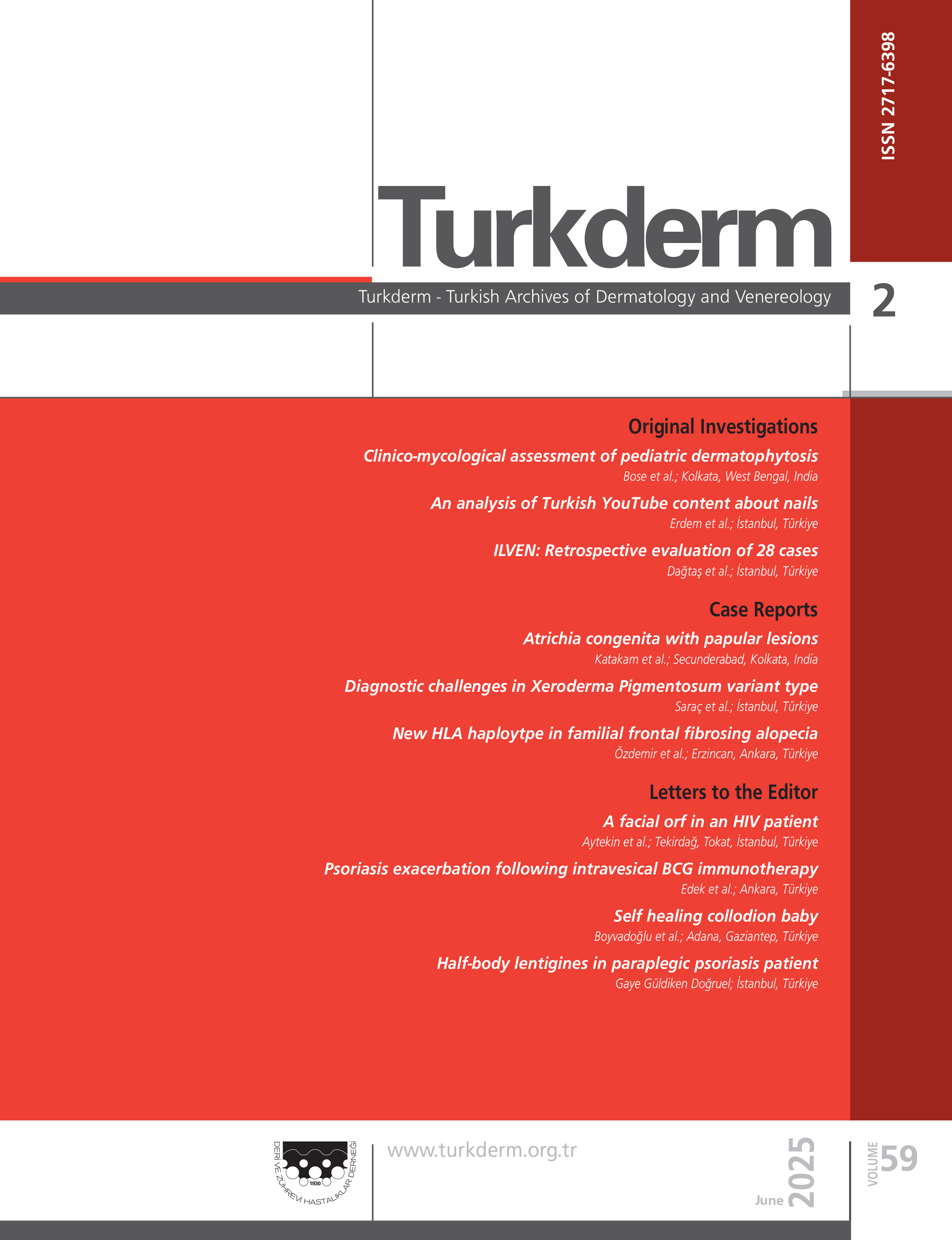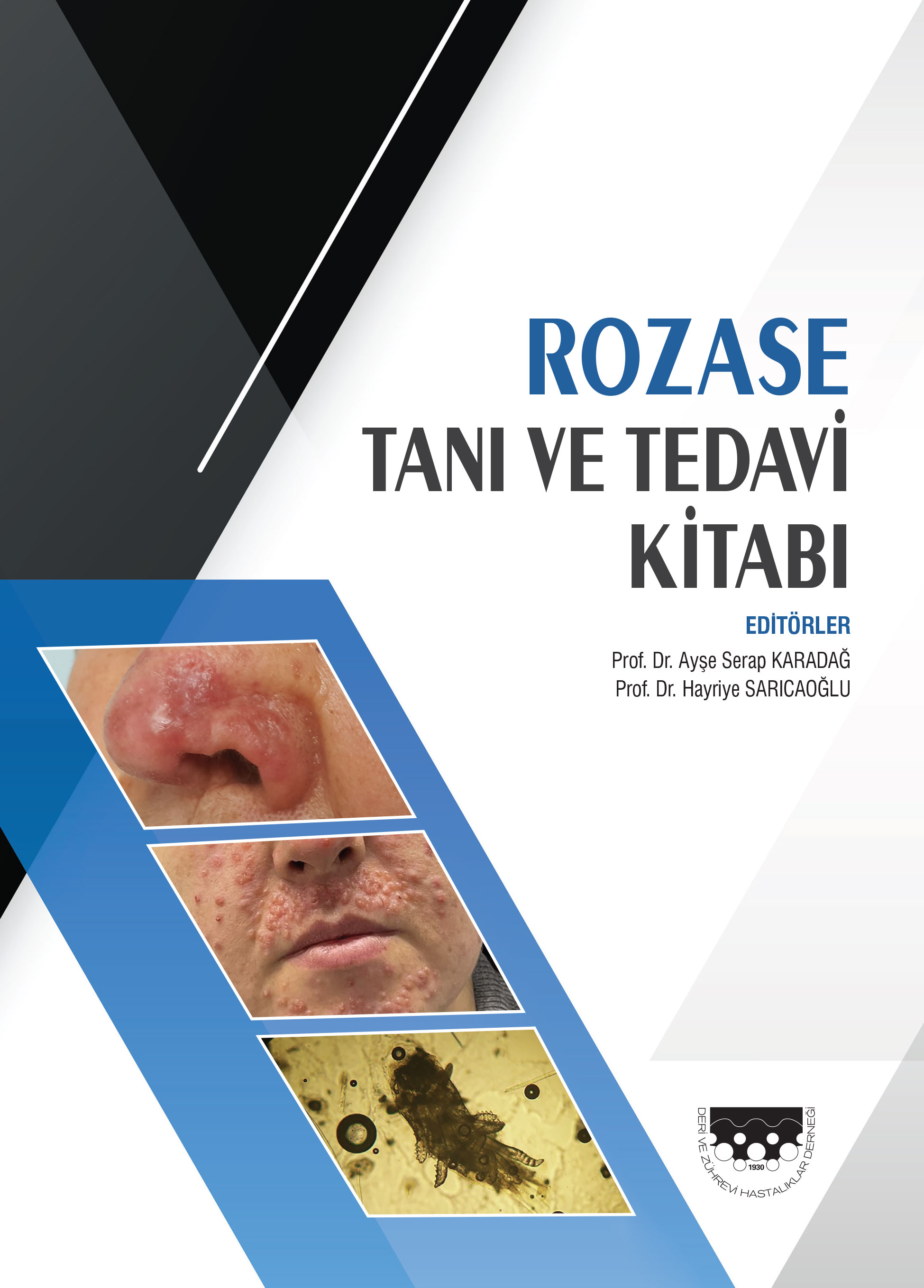Volume: 50 Issue: 2 - 2016
| EDITORIAL | |
| 1. | Editorial Ekin Şavk Page 41 Abstract | |
| REVIEW ARTICLE | |
| 2. | Disease severity scoring systems in dermatology Cemal Bilaç, Mustafa Turhan Şahin, Serap Öztürkcan doi: 10.4274/turkderm.67799 Pages 42 - 53 Scoring systems have been developed to interpret the disease severity objectively by evaluating the parameters of the disease. Body surface area, visual analogue scale, and physician global assessment are the most frequently used scoring systems for evaluating the clinical severity of the dermatological diseases. Apart from these scoring systems, many specific scoring systems for many dermatological diseases, including acne (acne vulgaris, acne scars), alopecia (androgenetic alopecia, tractional alopecia), bullous diseases (autoimmune bullous diseases, toxic epidermal necrolysis), dermatitis (atopic dermatitis, contact dermatitis, dyshidrotic eczema), hidradenitis suppurativa, hirsutismus, connective tissue diseases (dermatomyositis, skin involvement of systemic lupus erythematosus (LE), discoid LE, scleroderma), lichen planoplaris, mastocytosis, melanocytic lesions, melasma, onychomycosis, oral lichen planus, pityriasis rosea, psoriasis (psoriasis vulgaris, psoriatic arthritis, nail psoriasis), sarcoidosis, urticaria, and vitiligo, have also been developed. Disease severity scoring methods are ever more extensively used in the field of dermatology for clinical practice to form an opinion about the prognosis by determining the disease severity; to decide on the most suitable treatment modality for the patient; to evaluate the efficacy of the applied medication; and to compare the efficiency of different treatment methods in clinical studies. |
| ORIGINAL INVESTIGATION | |
| 3. | Evaluation of hyperandrogenemia and metabolic risk profile in women with postadolescent acne Leyla Baykal Selçuk, Deniz Aksu Arıca, Savaş Yaylı doi: 10.4274/turkderm.87854 Pages 54 - 58 Background and Design: Postadolescent acne is a disease with relapses frequently seen in women. Treatment is difficult. In our study, we aimed to investigate the clinical and biochemical characteristics of hyperandrogenism and the prevalence of metabolic disorders, such as metabolic syndrome (MS) and dyslipidemia in women with postadolescent acne. Materials and Methods: This study was conducted on 50 women who attended our department with the complaint of postadolescent acne between July 2014 and December 2014. The presence of androgenetic alopecia (AGA), hirsutism, polycystic ovary syndrome (PCOS), MS, dyslipidemia, and obesity was evaluated. Results: Seborrhea was present in 56%, hirsutism in 40%, AGA in 26%, and PCOS in 24% of women with postadolescent acne. The prevalence of MS and dyslipidemia was 24% and 44%, respectively. The prevalence of MS was significantly higher in patients with AGA and hirsutism. There was no association of MS with menstrual irregularity and PCOS. There was no significant association of dyslipidemia with AGA, hirsutism, PCOS, and menstrual irregularity. Conclusion: Clinical symptoms of hyperandrogenism, such as hirsutism, AGA, and PCOS were more common in women with postadolescent acne but androgenic hormone profile abnormalities were minimal. As a result, postadolescent acne resistant to treatment may be considered as an early marker in the early diagnosis of PCOS in women to prevent the development of type 2 diabetes mellitus, MS and hypercholesterolemia. |
| 4. | Skin findings in overweight and obese individuals Hülya Nazik, İbrahim Kökçam, Betül Demir, Feride Çoban Gül doi: 10.4274/turkderm.24654 Pages 59 - 64 Background and Design: The aim of the present study is to compare dermatoses detected in overweight and obese individuals with the data obtained from individuals with body mass index (BMI) below 25.0 kg/m2 and to emphasize the effects of obesity on skin health. Material and methods: The study was performed with 510 volunteer participants aged above 18 years, who were admitted to a policlinic. One hundred fifty individuals with normal weight who had a BMI below 25.0 kg/m2 constituted the control group, 130 individuals with BMI between 25.0-29.9 kg/m2 constituted the overweight group, and 230 individuals with BMI above 30.0 kg/m2 constituted the obese group. A detailed dermatological examination was performed and the data was recorded. Results: A total of 510 participants, 194 males and 316 females, were included in the study. The mean age was 32.05±10.9, 44.91±13.4, and 39.78±16.4 in the control, overweight, and obese groups, respectively. The most common dermatoses in the overweight and obese groups were striae distensae in 316 individuals (62%), plantar hyperkeratosis in 249 individuals (48.8%), dystrophic cellulitis in 216 individuals (42.4%), acrochordon in 204 individuals (40%), acanthosis nigricans 135 (26.4%), varicose veins in 134 individuals (26.3%), and keratosis pilaris in 108 individuals (21.2%). Conclusion: Several dermatoses are more frequently seen in obese and overweight individuals when compared with normal weight individuals due to insulin resistance and mechanical effects. |
| 5. | Survey study on training and implementation of dermatoallergy by the Turkish Society of Dermatology Dermatoallergy Study Group Emel Bülbül Başkan, Teoman Erdem, Ünal Erkorkmaz, Zübeyde Ceylan Kalın, Rabia Öztaş Kara doi: 10.4274/turkderm.82642 Pages 65 - 72 Background and Design: The Turkish Society of Dermatology, Dermatoallergy Study Group planned a survey study to search sources of knowledge and practices of dermatologists in the field of dermatoallergy and establish a basis for further educational activities and projects. Materials and Methods: In this survey, a questionnaire consisting of 42 questions was completed by the participants for detailed evaluation of their practices of patch, photopatch, prick, autologous serum skin testing, drug tests and occupational dermatitis, indications, number of applications, background sources, and allergen panel used. The survey was carried on either under the supervision of the group members in their area or by distributing and collecting the questionnaire during the Dermatoallergy panel of the 21st Prof. Dr. Lütfü Tat Symposium held in Ankara on 13-17 November 2013. Results: The results of our survey revealed that the most commonly used tests in dermatoallergy practice were prick test, patch test, drug test, autologous serum skin testing, and photopatch test, respectively. Conclusion: We found out that most of the dermatologists in Turkey have the sufficient knowledge and practice to perform dermatoallergy tests. However, further scientific training courses on oral food challenge and drug provocation tests are required to improve the practice of dermatologists. |
| CASE REPORT | |
| 6. | Clear cell basal cell carcinoma with neuroendocrine differentiation Cem Leblebici, Oğuzhan Okcu, Canan Kelten, Ayşe Esra Koku Aksu doi: 10.4274/turkderm.01069 Pages 73 - 76 Basal cell carcinomas (BCC) are tumors arising from pluripotent stem cells of the epidermis or hair follicles. There are many histological subtypes such as clear cell, a rare variant, and they have the capacity to differentiate towards distinct directions such as neuroendocrine differentiation (NED). An 81-year-old female patient presented with a mass on the lateral side of the right eyebrow. Excisional biopsy was performed. Histopathologic examination revealed clear cell BCC with prominent rosette-like structures suggesting NED. Immunohistochemically, tumor cells were positive for chromogranin and CD56. This is the first reported case of clear cell basal carcinoma with NED. |
| 7. | Intracranial hemorrhage with fatal outcome in a patient with heparin induced bullous hemorrhagic dermatosis Aslan Yürekli, Ercan Çalışkan, Deniz Doğan doi: 10.4274/turkderm.26779 Pages 77 - 78 Bullous hemorrhagic dermatosis is a rare adverse effect of subcutaneous heparin injection. Here, we report a case of hemorrhagic bullous dermatosis occurred after enoxaparin use. The patient's lesions had resolved but she died 45 days after development of hemorrhagic bullous dermatosis due to intracranial hemorrhage. |
| OTHER | |
| 8. | In memoriam Pages 79 - 80 Abstract | |























